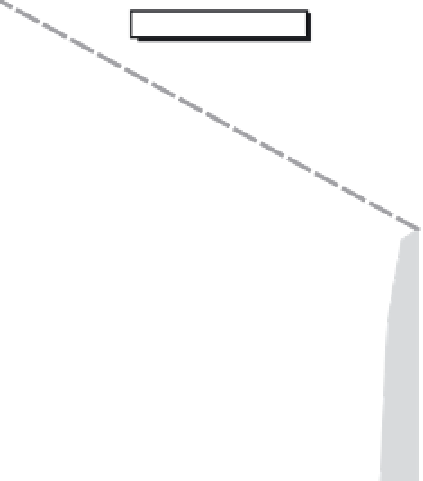Geology Reference
In-Depth Information
E
= presen
t
terrace
elevation
A
( = duration of uplift)
Meters
uplift rate =
D/A
40
e
= sea level
at time of
terrace
formation
present
sea level
0
Perspectives
on Sea-Level
Change
- 40
- 80
40
0
120
80
Age (ka)
Fig. 2.4
Relationship between relative, real, and apparent sea levels.
Apparent sea level is defined as the inverse of the vertical tectonic displacement (
D
). Displacement is determined as
the difference between the present elevation of a terrace (
E
) and the original elevation of the terrace (
e
); thus
D
=
E
−
e
. The rate of tectonic displacement is assumed constant here and is equal to the displacement divided by the
age (rate =
D
/
A
). Relative sea level is represented by the altitudinal position of preserved terraces with respect to
present sea level (dashed line). Real sea level represents actual changes in the height of the ocean surface. Because
the apparent and real sea levels add to yield the relative sea level, if two of these quantities are known, the third can
be derived. Modified from Lajoie (1986).
changes result from and represent the inverse
of the actual vertical displacement of the land,
that is, tectonic uplift or subsidence. For exam-
ple, if you are standing at present sea level, and
you see an ancient abrasion platform high
above you, either the sea level has fallen from
that elevated height to its present position (real
sea-level fall) or the terrace has been tectoni-
cally raised above the position at which it
formed (causing apparent sea-level fall), or
some combination of both effects has occurred.
Such deformation is clearly local or at most
regional in extent. If tectonic rates are assumed
to be steady during the time interval encom-
passed by a flight of terraces, then the appar-
ent sea-level change will be linear (Fig. 2.4).
In any case, apparent sea level represents the
difference between the relative and the real
sea-level change:
−
apparent = relative
real
So, how does one use these relationships to
calculate real sea-level changes in the past?
Consider a flight of emergent marine terraces
for which the age of each terrace and its
elevation above modern sea level are known.
This suite of terraces represents the relative
sea-level change through time. To determine the
apparent sea-level change, the tectonic uplift
rate has to be determined. If data from other
areas have revealed the position of sea level
at some time in the past with respect to the
present sea level, and if a terrace of that age is
present within the local succession, then the
difference between the present elevation of the
terrace and the elevation of the sea level at
the time the terrace formed defines the amount
of tectonic uplift. For example, if a 125-ka terrace


















































































